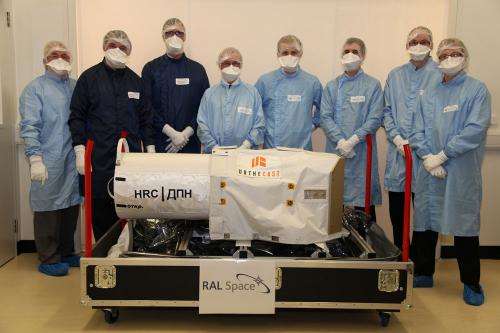STFC Built Cameras to offer the first ever near-live images of Earth

For the first time ever users across the globe will be able to view recent scenes and events on Earth from Space thanks to the launch this week of two new cameras built by STFC RAL (Rutherford Appleton Laboratory) Space.
A Soyuz Rocket launched from the Baikonur Cosmodrome in Kazakhstan on Monday with a payload to rendezvous with the International Space Station. On board were two cameras designed, built and tested at STFC RAL Space as part of the Urthecast project to install a high and medium resolution camera on the Russian module of the International Space Station. They are scheduled to arrive at the space station on Friday, 29th November and be installed during December.
RAL Space Engineers involved in the project, Ian Tosh, Tom Morse and Ed Jones, were at the Cosmodrome to watch the launch on Monday. Ian's video of the launch can be viewed on our YouTube site.
RAL Space Imaging Systems have designed, built and tested the two cameras. They will be installed on the Russian module of the International Space Station later this year. RAL Space worked with the Canadian-based company UrtheCast (pronounced 'Earth Cast') to develop the two cameras that will provide the first ever near-live images of Earth once fully operational.
The medium resolution camera (MRC) is essentially a modified version of RALCam3, an existing and reliable space camera. The MRC will be pointed directly down and take continuous images of Earth in 45km swaths at a resolution of 5m per pixel.
The second and most exciting camera is a high resolution video camera (HRC) mounted on a steerable platform. The RAL Space cameras interface with the data handling electronics, built by MDA in Canada, which pass the data through the ISS systems down to the ground where Urthecast make the images available for streaming to their customers and to the public. With a resolution of 1m per pixel individual vehicles could be viewed by this camera.
The HRC can also be controlled to continuously aim at a single point on the Earth's surface as the ISS passes overhead which allows the HRC to generate a video stream instead of single images. People will be able to track natural and man-made changes such as seasonal variations, congestion, natural disasters and deforestation in near real-time and over the course of many months and years. UrtheCast will build a catalogued archive of footage and images for public access, creating a utility for education and environmental awareness.
Provided by Science and Technology Facilities Council




















